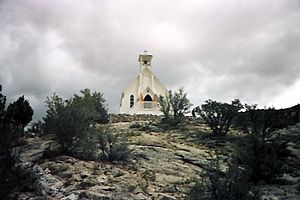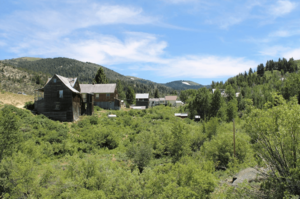Silver City, Idaho facts for kids
Quick facts for kids
Silver City, Idaho
|
|
|---|---|

Silver City in 1892
|
|
| Country | United States |
| State | Idaho |
| County | Owyhee |
| Elevation | 6,168 ft (1,880 m) |
| Time zone | UTC-7 (Mountain (MST)) |
| • Summer (DST) | UTC-6 (MDT) |
| GNIS feature ID | 398130 |
Silver City is a famous ghost town located in Owyhee County, Idaho, United States. A ghost town is a place that used to be a busy community but is now mostly empty. Silver City is listed on the National Register of Historic Places. In the 1880s, it was a busy town known for gold and silver mining. About 2,500 people lived there, and it had around 75 businesses.
Contents
A Historic Mining Town
Silver City was an important place in early Idaho history. It served as the main government center, or county seat, for Owyhee County from 1867 until 1934. Today, about 70 buildings are still standing in the town. All of these buildings are owned by private families. Many of the current owners are descendants of the original miners who lived there long ago.
Life in Silver City Today
Even though it's a ghost town, Silver City still has a few small businesses. However, there are no gas stations or car repair shops. The land where the town sits is owned by the U.S. federal government. It is managed by the Bureau of Land Management.
How Silver City Began
Silver City was founded in 1864. This happened soon after silver was discovered nearby at War Eagle Mountain. The town grew very quickly. It soon became one of the most important cities in Idaho Territory. Idaho Territory was an organized area of land that later became the state of Idaho.
Silver City was a leader in many ways. It was home to the first daily newspaper in Idaho Territory. It also had the first telegraph office. The town was among the first places in what is now Idaho to get electric and telephone service. Mining areas like Silver City helped the capital city of Boise grow. Boise became a key place for supplies and staging for miners.
The Decline of Mining
The mines in Silver City started to run out of valuable minerals around 1890. This was about the same time Idaho became a state. The town's very remote location also made it hard to keep going. Silver City began to slowly shrink, but it was never completely empty.
Some small-scale mining continued off and on. This lasted until World War II. The last mine to operate all year in Silver City was called the "Potossi." By the 1940s, only one person lived there all the time. His name was Willie Hawes. He was born in Silver City and held many jobs, like mayor and police chief.
The Idaho Hotel
The Idaho Hotel in Silver City was fixed up and reopened for visitors in 1972. It uses propane for its refrigerators and stoves. This allows it to offer cold drinks, snacks, and meals to guests during the summer. The rooms have modern plumbing and old-fashioned furniture. This makes the hotel a popular place for tourists to visit.
Silver City Historic District
In 1972, the entire town site and its surrounding area were added to the National Register of Historic Places. It became known as the Silver City Historic District. This means it is a special area protected for its historical importance. The district covers a large area of 10,240 acres (16.0 sq mi; 41.4 km2).
| Historical population | |||
|---|---|---|---|
| Census | Pop. | %± | |
| 1870 | 960 | — | |
| 1880 | 593 | −38.2% | |
| 1890 | 583 | −1.7% | |
| 1900 | 976 | 67.4% | |
| 1910 | 650 | −33.4% | |
| 1920 | 630 | −3.1% | |
| 1930 | 183 | −71.0% | |
| 1940 | 165 | −9.8% | |
| 1950 | 110 | −33.3% | |
| source: | |||
Location and Geography
Silver City is located high up in the mountains. Its elevation is about 6,179 feet (1,883 m) above sea level. It is about 25 miles (40 km) southwest of Murphy. Murphy is the current county seat for Owyhee County. You can reach Silver City by taking a dirt road.
See also
 In Spanish: Silver City (Idaho) para niños
In Spanish: Silver City (Idaho) para niños





